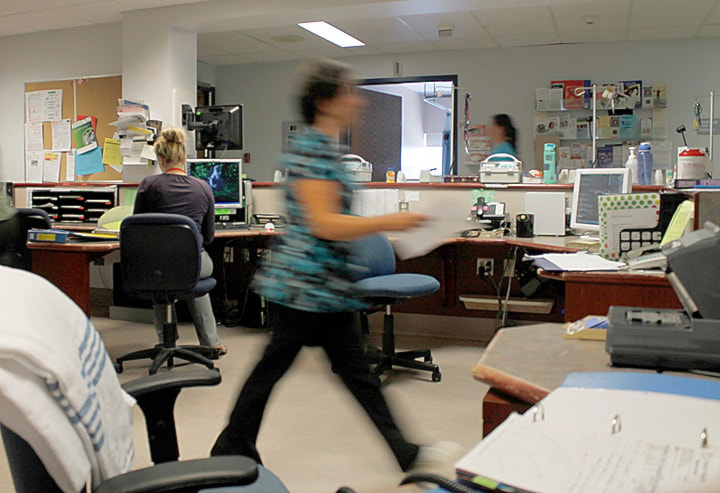It may seem counterintuitive to think the proposed $300-million expansion of Penticton’s hospital will address overcapacity issues despite not adding any new beds, but proponents insist it’s part of a strategy that will.
The new four-storey patient care tower would include expanded out-patient clinics, like respiratory and cardiology care, plus surgical suites and an oncology department. Those spaces would be sandwiched between a medical school on the bottom floor and a helipad on the roof. A five-storey parkade is planned to go up beside the tower.
Those spearheading the push have based their arguments on the claim that Penticton Regional Hospital routinely operates at 110 per cent of capacity, meaning the number of in-patients regularly exceeds the 134 funded beds in operation.
And that’s partly true.
In response to a freedom of information request, Interior Health provided occupancy data for PRH for April 29, 2011, to May 24, 2012. Broken into 14 periods, the numbers show the occupancy rate over that timeframe averaged 109.2 per cent.
The rate peaked at 112 per cent between June 24 and July 21, 2011, and bottomed out at 104.7 per cent between Jan. 6 and Feb. 2, 2012.
“Obviously we need to be prepared for surges or ups and downs in patient demand. But to sustain an overcapacity that we’ve been doing over the past 13 months is very difficult,” acknowledged Lori Motluk, a senior administrator at PRH.
To manage extra clients, the hospital is sometimes forced to keep new patients in the ER while they wait for a spot upstairs, where beds are occasionally placed in a “non-traditional room,” Motluk said, “like a lounge area.”
When things get really tough, major surgeries may be cancelled, as happened earlier this week, because there is nowhere to put patients to recover.
“Obviously we can’t wait five years to start addressing this, but the (new) building itself is a very important component of our strategy,” she said.
“So instead of building additional beds in the hospital, we’re looking at avenues to provide that kind of care in the community or through this ambulatory care building.”
The first part of the strategy includes increasing the number of residential-care beds in the community, where some patients who require nursing, but not necessarily a hospital, could be sent. Sixty-six such beds are under construction at Haven Hill Retirement Centre in Penticton.
The second part involves the new tower, Motluk said, which would provide more services for things that might currently require hospital stays, like minor surgeries, wound-dressing changes and IV treatments.
“It would be very easy to just add beds, but that’s not going to provide the quality of care that patients are telling us that they want, and that is to receive that as much as possible at home and close to their family,” Motluk said.
Nurses are skeptical.
“Putting in ambulatory care will obviously streamline the day-surgery procedures and have it all in one nice, little area along with the operating rooms,” said Kevin Barry, a regional executive member of the B.C. Nurses’ Union.
“But as to the overcapacity of the hospital and the workload being faced by the nurses, I’m not sure how it’s going to change that, unless Interior Health is going to come up with additional beds.”
Barry, who works at PRH, said Interior Health has consistently told the union it’s addressing the issue with more long-term care beds, but, “they keep adding to that and we stay at overcapacity.”
The other big claim attached to the PRH expansion is that the new building would not increase operating costs at the site.
Janet Perrino, chair of the Okanagan-Similkameen Regional Hospital District, said planners have told her that the tower could be operated with the same number of staff as the old facility. At least at first.
“As of Day 1, they think the efficiencies will be so amazing they will not have to look at additional operating costs,” Perrino said. “Over the years, of course it will increase and the government knows that too.”
Barry fears the efficiencies will be squeezed out of overburdened staff, as he said has happened at the newly expanded Kelowna General Hospital.
“I know from the Kelowna experience what they’re finding is it’s a great new building to work in, but it’s got a lot more square footage for the nurses to cover,” he said. “So it’s the same number of nurses walking longer distances to get their work done.”
So far, the Regional District of Okanagan-Similkameen has committed to provide $120 million for the PRH expansion and the hospital foundation has pledged to raise another $20 million, which puts the B.C. government’s required buy-in at $160 million.
Perrino this summer launched a campaign that encouraged businesses throughout the South Okanagan to write to provincial politicians in support of the project. A concept plan for the expansion was submitted to government earlier this summer for consideration during fall budget deliberations.
